Filet Mignon with Red Wine Sauce
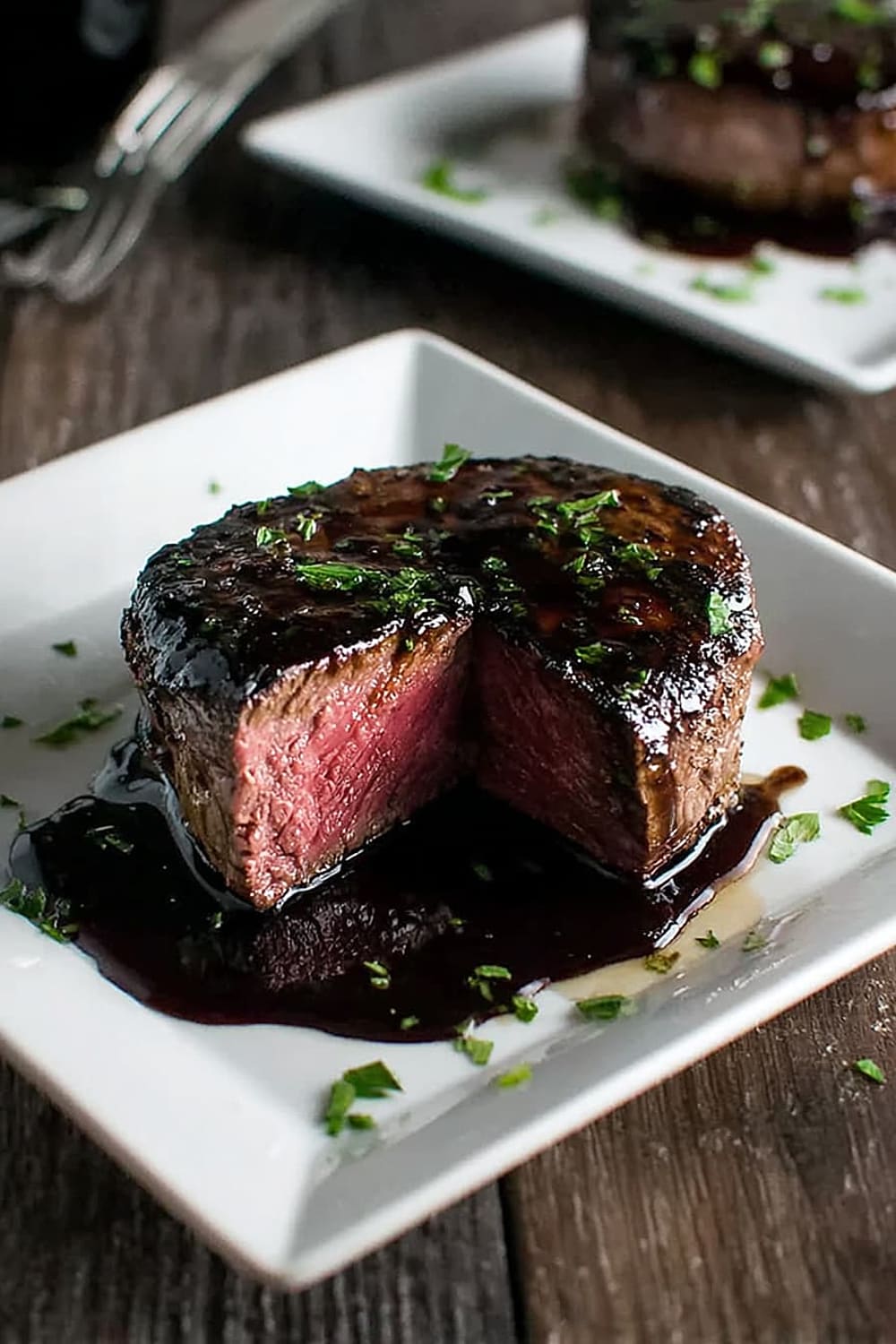
This recipe is basically the culinary equivalent of putting on your fanciest outfit – it makes you feel like you’ve got your life together, even if you’re just winging it.
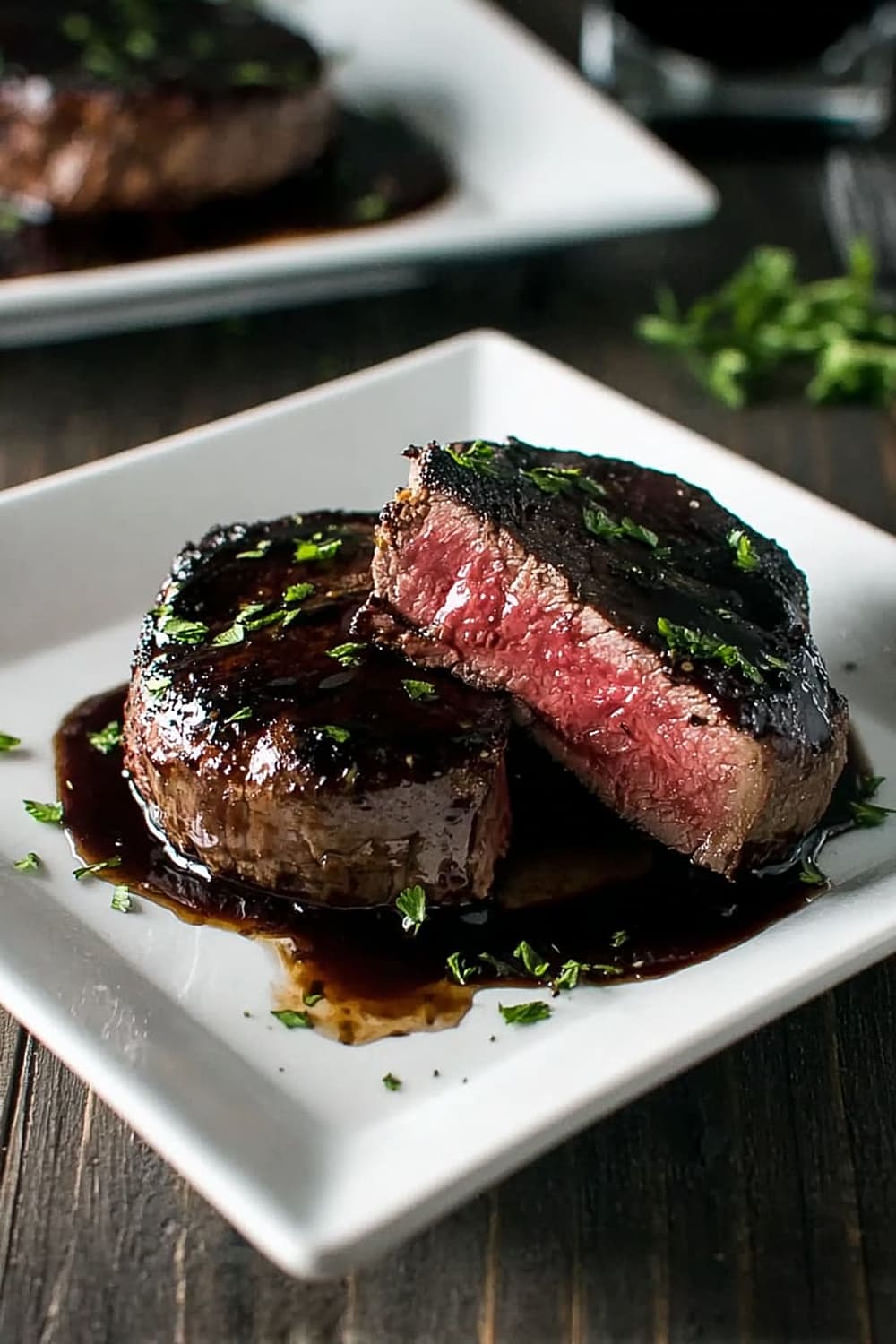
Warning: making this will result in people asking if you went to culinary school, when really you just followed directions and didn’t panic when the pan started smoking.

The red wine reduction is pure liquid gold that transforms a simple steak into restaurant-quality magic, and honestly, it’s easier than convincing yourself to go to the gym.
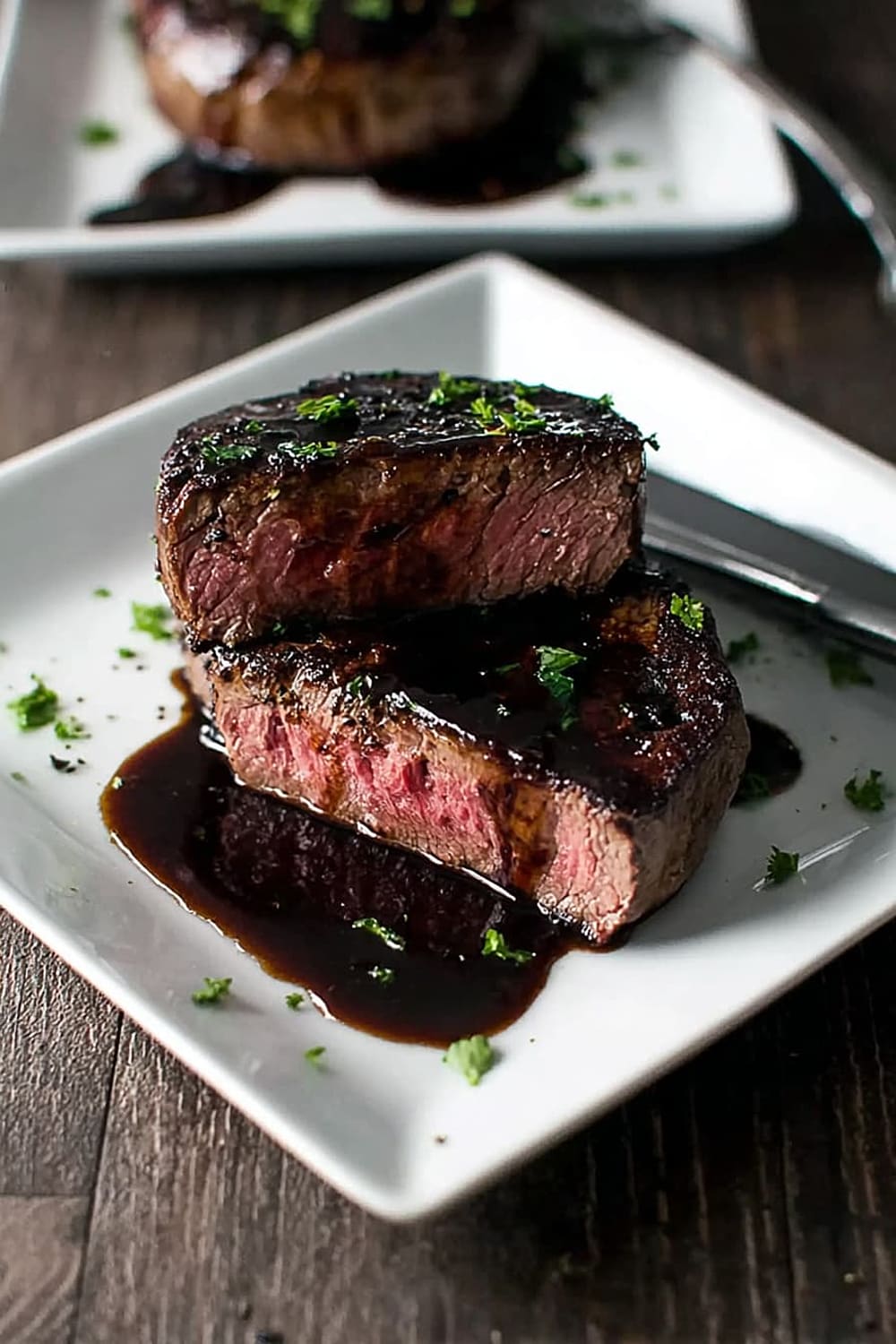
This is the kind of dish that makes you feel like a cooking show host, complete with the dramatic pan searing and the satisfying sizzle that says “I know what I’m doing.”
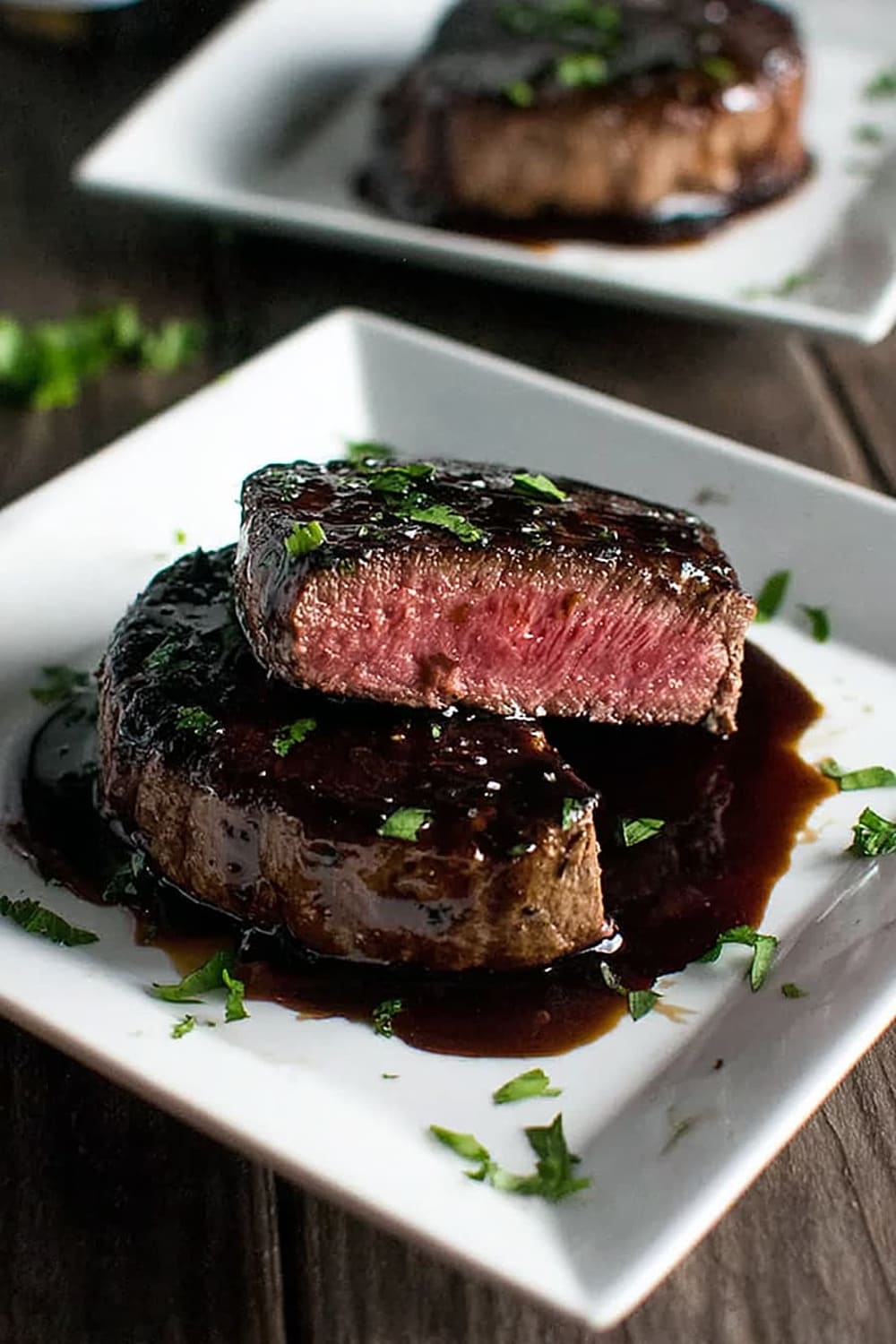
Prepare yourself for the ultimate compliment: “Wait, you actually MADE this?” Yes, Karen, some of us can create five-star dining experiences in our own kitchens.
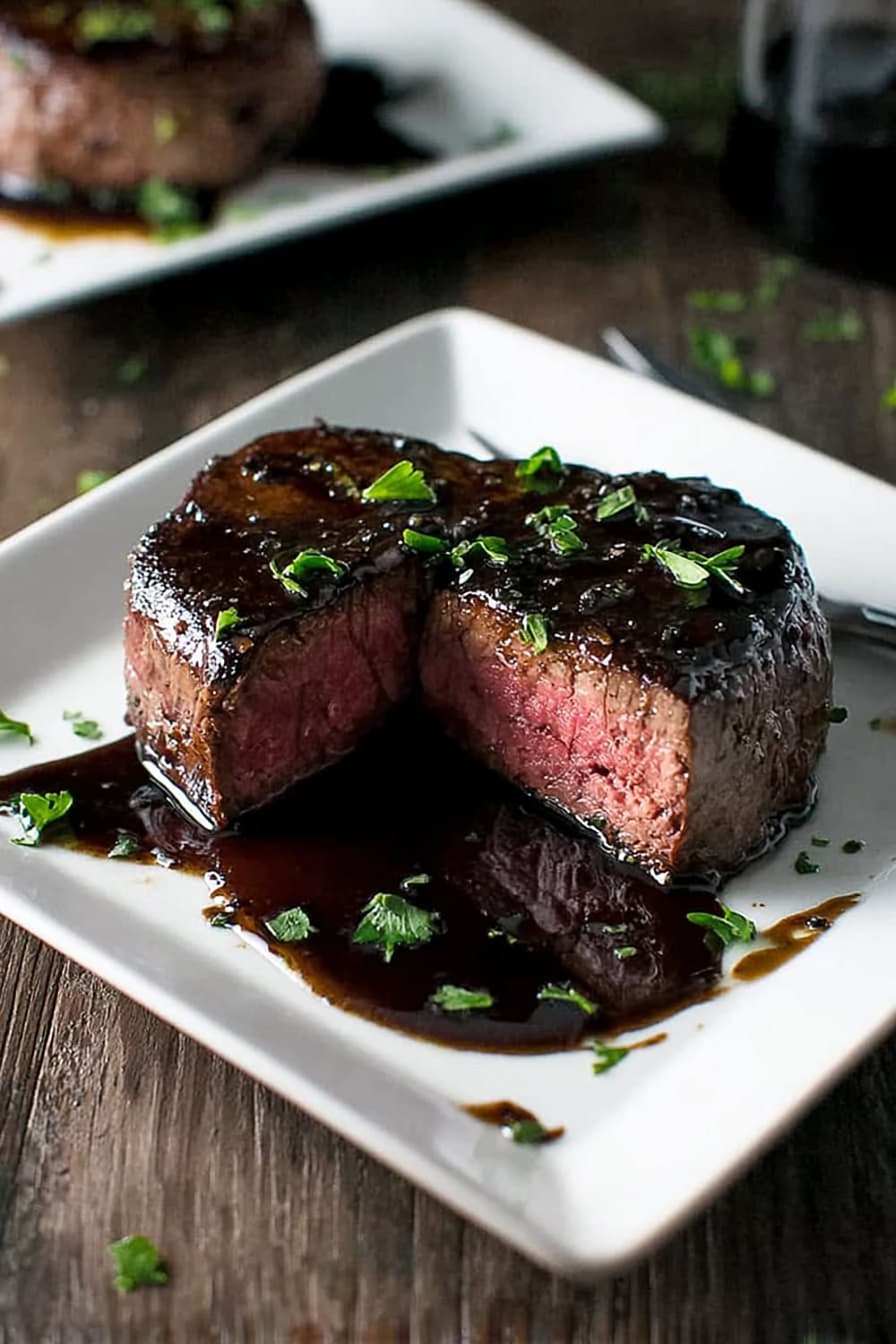
About to become your secret weapon when you need to impress someone but don’t want to stress-sweat through the entire cooking process – because let’s be real, confidence is half the recipe.
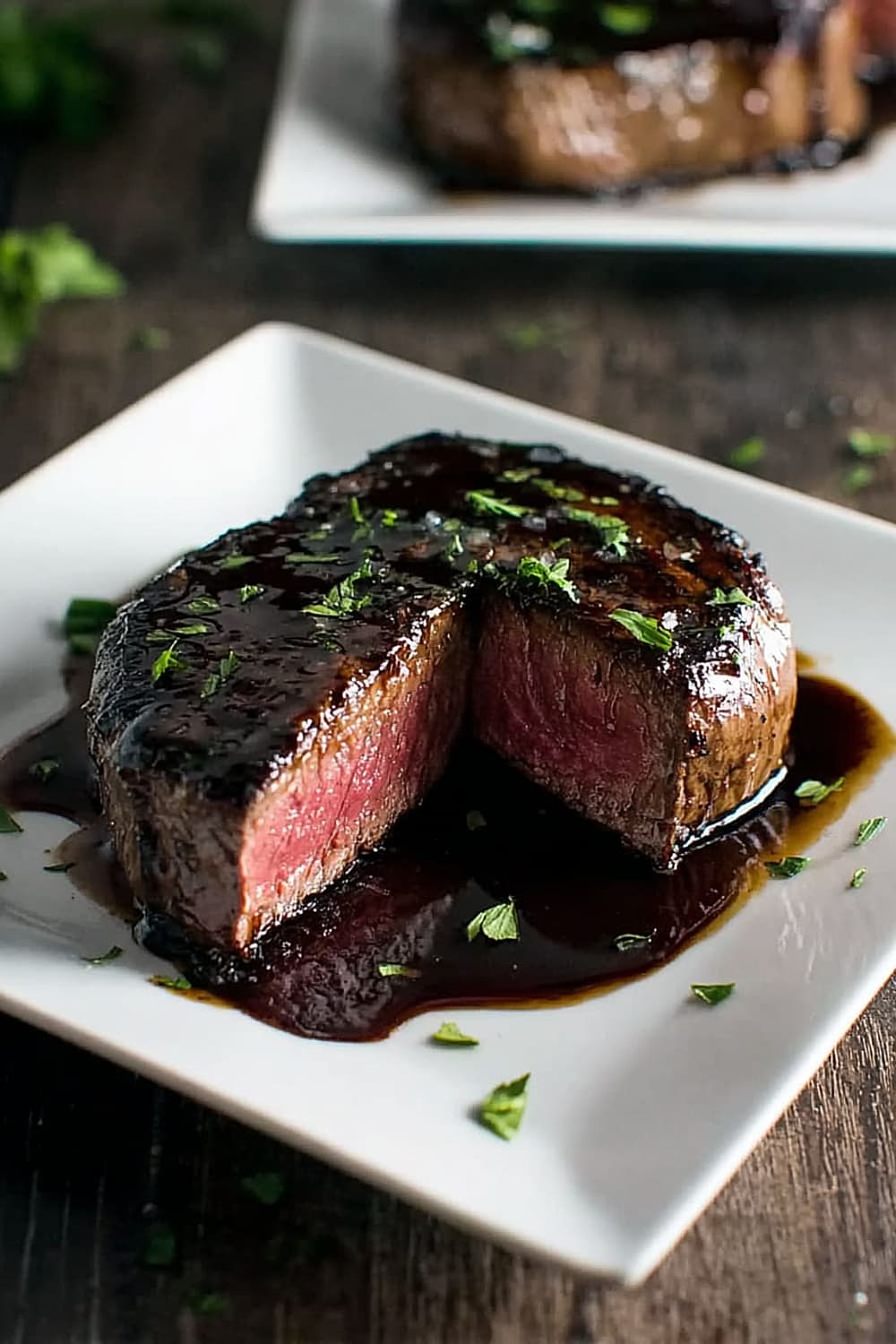
Ingredients
For the Filet Mignon
- 2 (8-10 ounce) tenderloin beef filets (filet mignon), roughly 2 inches thick
- 1 tablespoon vegetable or canola oil
- Salt and pepper to taste
- 1 sprig fresh rosemary
- 1 garlic clove, whole
- Chopped parsley or rosemary for garnish, optional
For the Red Wine Reduction
- 1 /2 cup dry red wine (Chianti recommended)
- 1 /2 cup balsamic vinegar
- 1 tablespoon butter
- 1 tablespoon brown sugar, packed
- Pinch of salt and pepper
Instructions
Preparation
- 1 Preheat your oven to 415°F (213°C). Remove the steaks from the refrigerator 30 minutes prior to cooking to bring them to room temperature – this ensures even cooking and more accurate timing. An instant-read thermometer can help you monitor the internal temperature throughout the process.
- 2 Season all sides of the filets liberally with salt and pepper while they come to room temperature. This gives the seasoning time to penetrate the meat and creates that perfect crust we’re after.
Searing the Filets
- 3 Add 1 tablespoon oil to an oven-safe cast iron skillet – you only need a light coating to prevent sticking. Turn the heat to high and allow the skillet to become very hot. Swirl the pan to distribute the oil as it heats, watching for the telltale shimmer that indicates readiness.
- 4 Once the oil starts to smoke (this is your cue!), carefully place the filets face down in the pan and sear undisturbed for 2 minutes. Resist the urge to move them – this creates that gorgeous caramelized crust. Flip the filets using tongs and sear for an additional 2 minutes on the other side.
Oven Finishing
- 5 Optional but recommended: add herb butter, the whole garlic clove, and fresh rosemary sprig to the pan before transferring to the oven. The butter will melt and the aromatics will infuse the pan drippings with incredible flavor for later basting.
- 6 Transfer your skillet directly to the preheated oven using oven mitts (that handle will be screaming hot!). Cook according to your preferred doneness: 4 minutes for rare, 5-6 minutes for medium-rare, 6-7 minutes for medium, or 8-9 minutes for medium-well. Remember, thicker steaks need slightly longer cooking times.
- 7 Remove from oven and optionally spoon the seasoned pan drippings over each steak to infuse extra flavor and moisture.
Making the Red Wine Reduction
- 8 While the steaks rest, whisk together the red wine, balsamic vinegar, brown sugar, and a pinch of salt and pepper in a small saucepan. Bring this mixture to a rolling boil over medium-high heat.
- 9 Reduce heat to maintain a gentle simmer, stirring frequently to prevent the vinegar and wine from burning on the bottom. Continue simmering until the mixture reduces by half and reaches your desired thickness, typically 10-15 minutes. The glaze will continue to thicken as it cools, so don’t over-reduce.
- 10 Top each filet with as much of the glossy red wine reduction as desired and serve immediately while the steaks are still hot.
Recommended Equipment and Kitchen Tools
Essential Tools (for best results)
- Cast iron skillet – The heavy-duty construction retains heat beautifully for perfect searing and transitions seamlessly from stovetop to oven
- Instant-read thermometer – Takes the guesswork out of achieving your preferred doneness level
- Quality tongs – Essential for flipping steaks without piercing the meat and losing those precious juices
- Small saucepan – Needed for creating the red wine reduction with proper heat control
Helpful Upgrades
- Digital kitchen scale – Professional chefs swear by weighing ingredients for consistent results, especially when scaling recipes
- Silicone spatula – Perfect for stirring the reduction without scratching your cookware
- Oven mitts with extended cuffs – Extra protection when handling that blazing-hot cast iron skillet
Nice-to-Have Options
- Microplane grater – Ideal if you want to add fresh garlic or citrus zest to enhance the reduction
- Fine-mesh strainer – For an ultra-smooth reduction if you prefer restaurant-style presentation
- Aluminum foil tenting – Helps steaks rest properly while maintaining temperature
Recipe Variations and Dietary Modifications
Wine Variations
- Cabernet Sauvignon → Creates a bolder, more robust reduction with deeper flavors
- Merlot → Produces a smoother, fruitier sauce profile
- Non-alcoholic option → Substitute with grape juice plus 1 tablespoon red wine vinegar for complexity
Herb and Aromatics
- Fresh thyme → Swap rosemary for a more delicate, earthy flavor
- Shallots → Add 1 minced shallot to the reduction for extra depth
- Garlic lovers → Increase to 2-3 cloves and mince them into the reduction
Sauce Modifications
- Honey glaze → Replace brown sugar with 1 tablespoon honey for floral sweetness
- Port wine reduction → Substitute half the red wine with port for luxurious richness
- Butter finish → Whisk in an extra tablespoon of cold butter at the end for glossy richness
Cooking Method Alternatives
- Grill adaptation → Sear on high heat grill, finish in indirect heat zone
- Sous vide precision → Cook steaks sous vide first, then sear for crust
- Pan-only method → Reduce oven temperature and cook entirely on stovetop for thinner cuts
Nutritional Information and Health Benefits
Key Nutritional Highlights
This elegant dish provides approximately 650-750 calories per serving, with the majority coming from high-quality protein. Each filet delivers roughly 45-50 grams of complete protein, containing all essential amino acids your body needs for muscle maintenance and repair. The red wine reduction adds minimal calories while providing powerful antioxidants, and the overall carbohydrate content remains low at just 8-10 grams per serving.
Health Benefits of Main Ingredients
Grass-fed beef provides exceptional amounts of iron, zinc, and vitamin B12, crucial for energy metabolism and immune function. The balsamic vinegar contains beneficial acetic acid, which may help with blood sugar regulation and digestion. Red wine contributes resveratrol and other polyphenols with anti-inflammatory properties, though the alcohol content cooks off during reduction. Fresh herbs like rosemary provide antioxidants and have been linked to improved cognitive function.
Dietary Considerations
This recipe naturally fits ketogenic, paleo, and low-carb dietary patterns perfectly. It’s naturally gluten-free and dairy-free (if you omit the optional butter). The high protein content makes it excellent for those focused on muscle building or weight management, while the rich flavors ensure satisfaction with reasonable portions.
Smart Swaps and Ingredient Substitutions
Protein Alternatives:
- Filet mignon → New York strip or ribeye (adjust cooking times for thickness differences)
- Beef tenderloin → Pork tenderloin (reduce cooking time by 2-3 minutes)
- Budget-friendly option → Sirloin steaks (may need tenderizing with marinade)
Wine Substitutions:
- Dry red wine → Beef broth plus 1 tablespoon red wine vinegar for depth
- Chianti → Pinot Noir or Burgundy for different flavor profiles
- Alcohol-free → Grape juice mixed with balsamic vinegar in 1:1 ratio
Pantry Emergency Substitutions:
- Balsamic vinegar → Red wine vinegar plus 1 teaspoon brown sugar
- Brown sugar → Maple syrup or honey (reduce liquid slightly)
- Fresh rosemary → 1 teaspoon dried rosemary or fresh thyme
Pro Tips for Substitutions:
- When using different cuts of meat, adjust cooking times based on thickness rather than weight
- Store leftover reduction covered in refrigerator for up to 1 week – it’s fantastic on roasted vegetables too
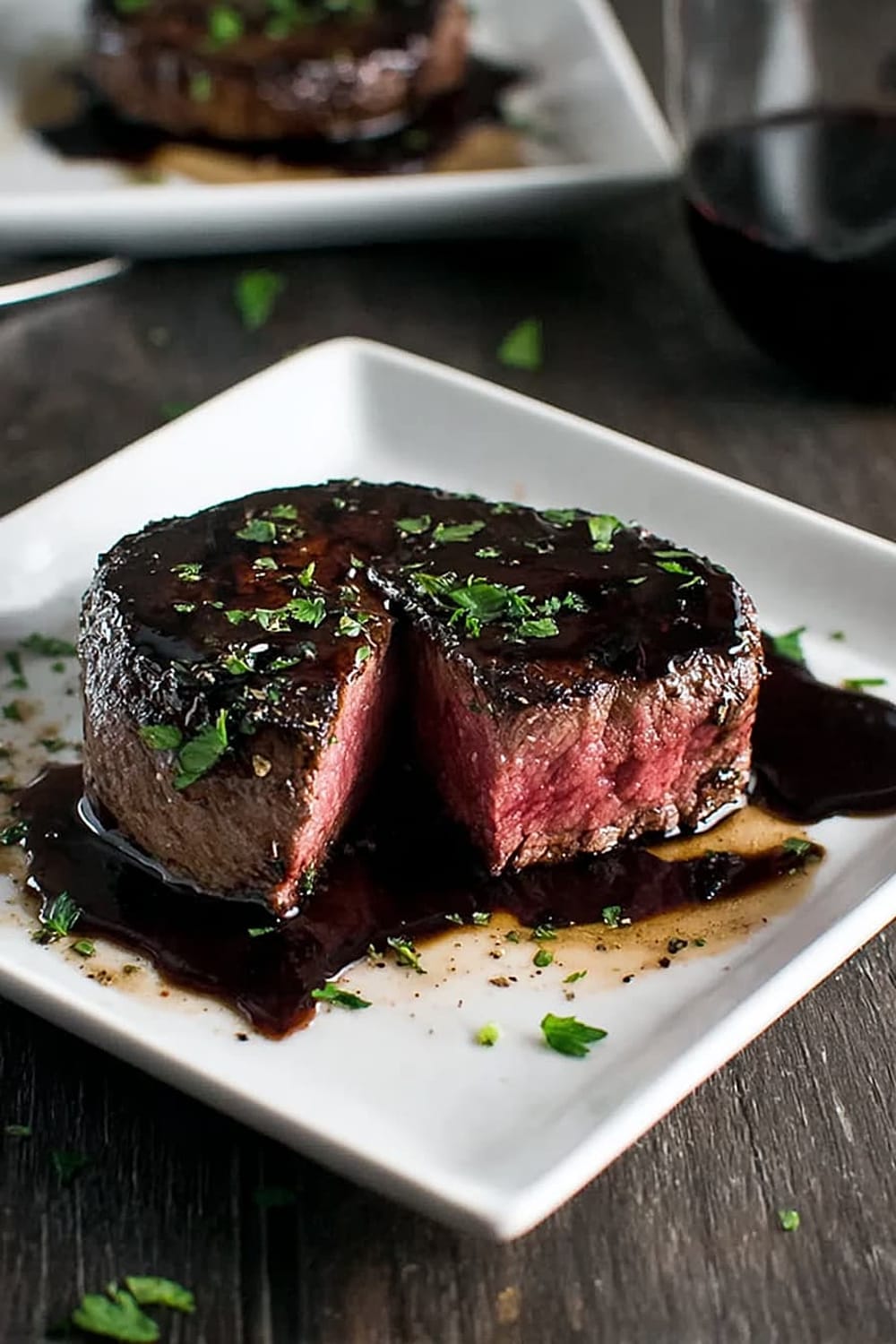
Make It Diabetes-Friendly
Carb Reduction Strategies:
- Original brown sugar: 12g carbs → Sugar-free brown sugar substitute: 0-2g carbs
- Balsamic vinegar: Keep the same amount as it adds only 2g carbs but provides essential flavor depth
- Total recipe carbs reduced from 16g to 4g per serving
Blood Sugar Management Tips:
- Pair with fiber-rich vegetables like roasted asparagus or sautéed spinach to slow glucose absorption
- Portion control: Stick to the 8-ounce filet serving size for optimal protein without excess calories
- Timing strategy: The high protein content helps stabilize blood sugar for 3-4 hours post-meal
Smart Modifications:
- Replace brown sugar with erythritol or monk fruit sweetener in equal amounts
- Add extra herbs like thyme or oregano to enhance flavor without carbs
- Include healthy fats through avocado or olive oil drizzle to further slow carb absorption
Estimated Carb Content: 4g net carbs per serving with modifications, making it excellent for diabetic meal planning.
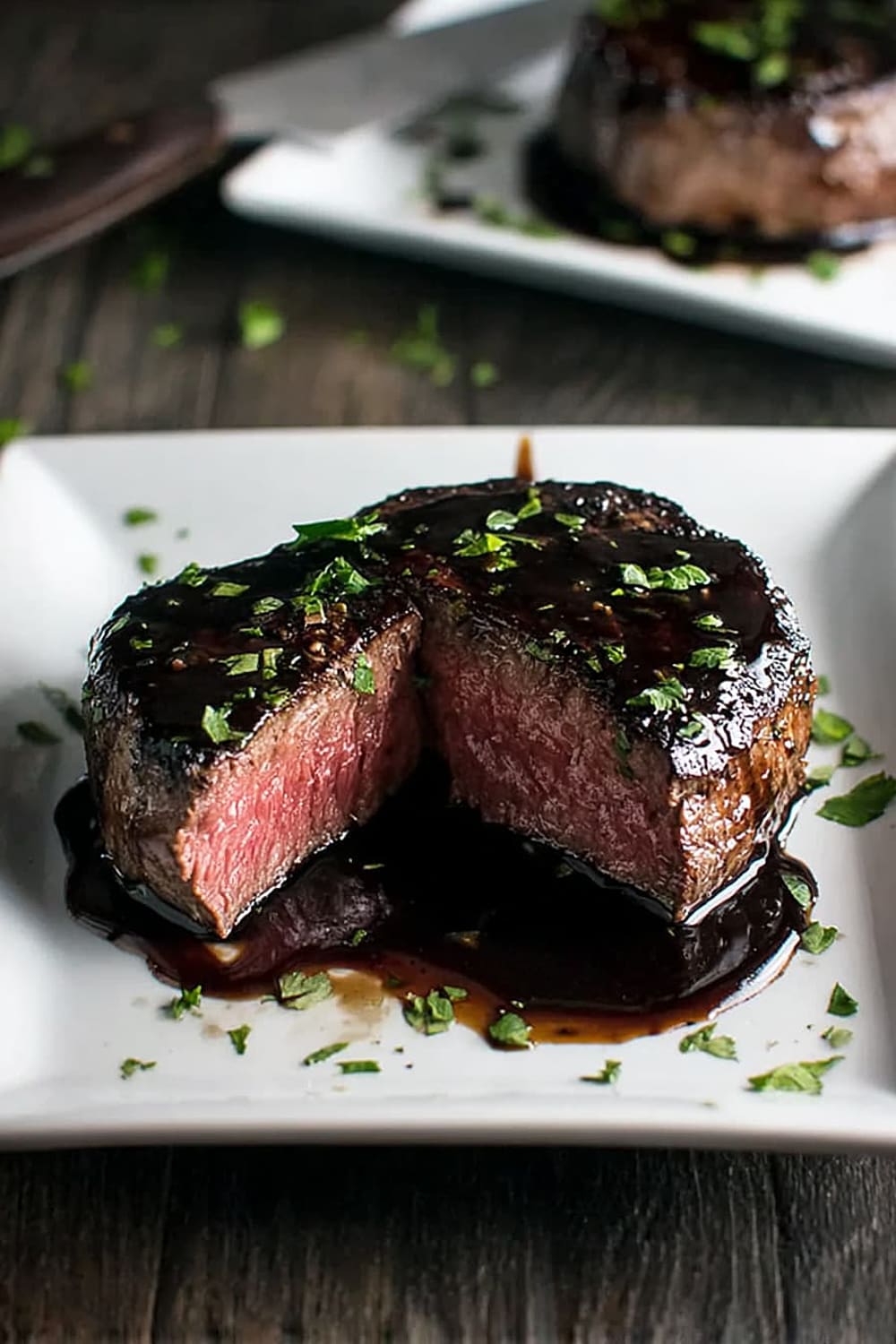
Perfect Pairing Suggestions
Wine Pairings
The rich, savory flavors of this filet pair beautifully with full-bodied red wines like Cabernet Sauvignon, Malbec, or a good Bordeaux blend. The tannins complement the meat’s richness while the wine’s fruit notes echo the reduction. For white wine lovers, try an oaked Chardonnay or Viognier with enough body to stand up to the beef.
Side Dish Recommendations
Roasted asparagus with garlic provides a crisp contrast to the tender meat, while truffle mashed potatoes create an indulgent steakhouse experience. Sautéed mushrooms with herbs complement the earthy flavors, and grilled broccolini adds color and nutritional balance. For lighter options, consider arugula salad with lemon vinaigrette to cut through the richness.
Complete Meal Ideas
Start with oysters Rockefeller or burrata with roasted tomatoes as sophisticated appetizers. Follow with the filet as your centerpiece, accompanied by roasted fingerling potatoes and seasonal vegetables. Finish with dark chocolate mousse or crème brûlée to complete the restaurant-quality experience.
Occasion Suggestions
This dish shines for anniversary dinners, Valentine’s Day, or any time you want to create a special evening at home. It’s perfect for intimate dinner parties of 2-4 people and elegant enough for holiday entertaining when you want to impress without spending all day in the kitchen.
Pro Tips and Troubleshooting
Professional Techniques
Always let your steaks rest for 5 minutes after cooking – this allows juices to redistribute throughout the meat for maximum tenderness. Use the finger test to check doneness: rare feels like the fleshy part between your thumb and forefinger when relaxed, while medium-rare feels like that same spot when you make an “OK” sign. For the reduction, taste as you go and adjust sweetness or acidity to your preference.
Common Mistakes and Solutions
Overcrowding the pan prevents proper searing – cook steaks one at a time if necessary. Moving the steaks too early prevents crust formation – trust the timing and let them sear undisturbed. Over-reducing the sauce creates a sticky mess – remember it thickens as it cools, so err on the side of slightly thin.
Storage and Make-Ahead
The red wine reduction can be made 2-3 days ahead and refrigerated – simply reheat gently before serving. Leftover cooked steaks keep for 3-4 days refrigerated and can be sliced thin for salads or sandwiches. For best results, bring steaks to room temperature before reheating gently in a low oven.
Scaling the Recipe
This recipe doubles easily for 4 servings – just use a larger cast iron skillet or cook in batches. The reduction recipe makes enough for 4 steaks, so you’re already covered. For larger crowds, consider making the reduction in a larger saucepan to prevent scorching.
The beauty of this filet mignon lies not just in its restaurant-quality results, but in how achievable it is for home cooks who want to create something truly special. With the right technique and a little confidence, you’ll have a dish that rivals the best steakhouses – and the satisfaction of knowing you created it yourself.